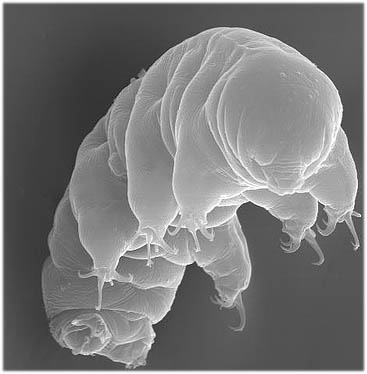Space is extremely cold, near absolute zero, and it is a vacuum, so no oxygen, plus there is the threat of lethal radiation from stars. It is considered the most hostile of environments, where unprotected humans would last for a fraction of a second.
But research by Ingemar Jönsson and colleagues in Current Biology shows that some animals — the tardigrades, or 'water-bears' — can do away with space suits and can survive exposure to open-space vacuum, cold and radiation just fine.

This is the first time that any animal has been tested for survival under open-space conditions. The test subjects were chosen with great care: Tardigrades — also known as water-bears — are tiny invertebrate animals from 0.1 to 1.5mm in size that can be easily found on wet lichens and mosses. Because their homes often fall dry, tardigrades are very resistant to drying out and can even resurrect after years of dryness. Along with this amazing survival trick comes extreme resistance to heat, cold and radiation — so tardigrades seemed like an ideal animal to test in space.
The dried-up tardigrades were aboard the FOTON-M3 spacecraft launched by the European Space Agency (ESA) in September 2007 and were exposed to open space conditions — i.e. to vacuum, UV radiation from the sun and cosmic radiation — in a low Earth orbit of around 270km altitude. After their safe return to Earth, it turned out that while most of them survived exposure to vacuum and cosmic rays alone, some had even survived the exposure to the deadly levels of solar UV radiation, which are more than 1,000 times higher than on the surface of the Earth.
Even more so, the survivors could even reproduce fine after their space trip.
The tardigrades extreme resistance to UV radiation is perhaps most surprising. UV rays consist of high-energy light particles that cause severe damage to tissue, as is evident when you get a sun-burn. But more so, they can also damage the cell's genetic material, causing for instance skin cancers. For this reason UV is deadly for most organisms —it is even used as a sterilising agent.
As Jönsson and colleagues write: "How these animals were capable of reviving their body after receiving a dose of UV radiation of more than 7000 kJm-2 under space vacuum conditions […] remains a mystery."
It is conceivable that the same cellular adaptations that let them survive drying out might also account for their overall hardiness.
The researchers include K. Ingemar Jönsson, Kristianstad University, Kristianstad, Sweden; Elke Rabbow, Institute of Aerospace Medicine, Radiation Biology Division, Köln, Germany; Ralph O. Schill, Biological Institute, Universität Stuttgart, Stuttgart, Germany; Mats Harms-Ringdahl, Stockholm University, Stockholm, Sweden; and Petra Rettberg, Institute of Aerospace Medicine, Radiation Biology Division, Köln, Germany.






Comments